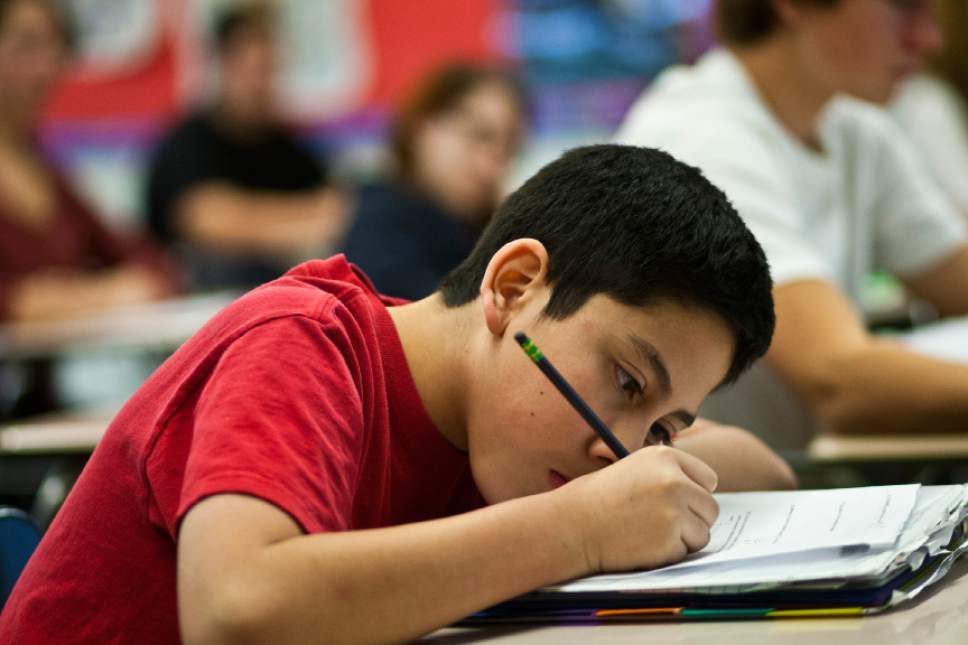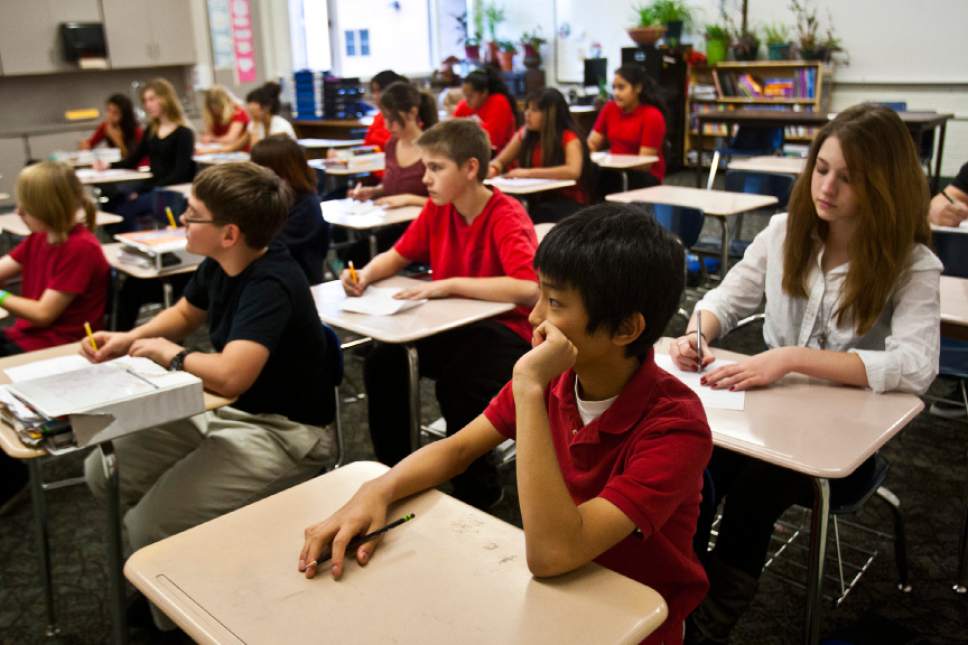This is an archived article that was published on sltrib.com in 2015, and information in the article may be outdated. It is provided only for personal research purposes and may not be reprinted.
When Randy Koziatek's daughter was in seventh grade, he felt "strong pressure" from other parents to enroll her at Clayton Middle School.
The family lived within the boundaries for Bryant Middle School, but Clayton was seen as the better choice, partly because of its higher test scores and school grade.
After looking into both schools, the small class sizes and dedicated staff at Bryant persuaded Koziatek to keep his daughter in the neighborhood.
"I thought the kind of guidance and care that they took for the students was just phenomenal," he said. "She wasn't just one in the crowd."
On paper, Bryant, 40 South and 800 East, encompasses the northeast corner of Salt Lake City, from Poplar Grove to the University of Utah, through Central City, Capitol Hill and The Avenues.
But last year, 219 students in that area took advantage of Utah's open-enrollment law to flee from the school; 80 of them migrated three miles southeast to Clayton Middle School, 1470 S. 1900 East, according to data from the Salt Lake City School District.
Open enrollment — which began in Utah in the 1990s, with various amendments since — allows a student to enroll at any school in the state with available space.
The transfers affect school demographics. While most of the students in the Salt Lake City School District are not Caucasian, district data show the middle schools on the losing side of school-choice trends have higher levels of diversity.
Though Bryant draws from ZIP codes with a majority Caucasian population, according to census data, 76 percent of its students last year were members of a racial or ethnic minority. Clayton was 32 percent minority students.
There's a correlation between the diversity of a school and its performance on standardized tests and school grading, a Salt Lake Tribune analysis found in January.
It's a "feedback loop," Koziatek said, where perception of a school's quality results in parents taking actions that further skew school demographics and performance.
Open enrollment relies on parents to transport students, and not every family has the time or resources to send a child across town.
That disparity, school-choice critics say, makes open enrollment an option mostly for affluent families and encourages "white flight" — the segregation of schools based on income and ability.
—
Commuter students • "School choice came about as a way to try and deal with overcrowding, initially, and then it was somewhat politically driven as an option," said McKell Withers, the departing superintendent of Salt Lake City School District.
Roughly one out of every four students in Salt Lake City attends school outside his or her home neighborhood, Withers said. And the city gains more students than it loses as parents who work in the state's capital bring their children with them on their morning commutes.
"Some of my parents don't have cars and getting their kids on a bus would be daunting," Lincoln Elementary School Principal Peggy Paterson said.
Withers said the challenges surrounding school choice are part of why the Utah Office of Education's system of grading schools is flawed.
Ostensibly meant to evaluate school performance, school grades are based on test scores, which educators argue is more a reflection of ZIP code than the efficacy of teachers.
"Some segregation would occur based on perception and then that gets exacerbated," Withers said. "There's no question that [school] choice has upsides and downsides you need to pay attention to."
Withers said Salt Lake City School District tries to mitigate school flight by leveling the playing field of school choice.
The district provides limited out-of-boundary bus service for its magnet and accelerated learning programs. And a district charter school, the Salt Lake Center for Science Education, was intentionally placed on the city's more diverse west side.
"You try and temper the flight that occurs just based on test scores and school grades," he said, "by having multiple options."
Withers also said that pockets of diversity are not necessarily indicative of school flight — as long as they reflect the community.
"Increased diversity, I think, would be a good thing," he said. "But the absence of neighborhood kids ought to really set off alarms."
Those alarms are effectively ringing at Lincoln Elementary, where Paterson said neighborhood children have vanished.
"The people who elect to go elsewhere are generally the families who live right near the school," she said.
"It's hard to see that perception that this school is not as good of a fit for their child as a school that is maybe a half-mile east."
Lincoln Elementary, 1090 S. Roberta St. (250 East), is a Title 1 school, meaning it receives supplemental funding to offset the effects of a low-income population.
This year, Lincoln showed the largest improvement on its standardized test scores of any Title 1 school in the district.
But Paterson said it's hard to shake the reputation of a failing school.
"I know that the history of a school can live on way beyond the reality of the school," she said. "It's very hard to change perception."
Nancy Schwebach's daughter attended Lincoln Elementary last year, and she said it was a positive experience for the family.
But many of her neighbors had an "anywhere but Lincoln" mentality, she said. "They absolutely refuse to let their kids go there. They do not want their kids being associated with Lincoln."
—
School visits • Rather than promote community segregation, school choice minimizes it, according to Salt Lake City school board member Michael Clara.
He said if families were locked into attending their nearest school, they would uproot themselves and move to greener pastures.
Instead, open enrollment allows them to stay put.
"I don't see them leaving," he said, "because they can make a conscious choice to just go to an east-side school."
Clara represents the city's west side and has made several allegations of racial discrimination against the school district.
He said school choice empowers families to address the needs of their children — even if that means leaving the neighborhood behind.
"I don't begrudge a parent making that decision," he said.
But without nearby families, Paterson said, schools lose out on vital parental involvement and volunteerism.
Rather than remove a student from a low-performing school, and cause scores to fall further as a result, Koziatek said, parents should work toward improvement.
"If a school is perceived to have less quality than another school," he said, "I feel like the best thing we can do is to have parents stand up and demand equity from the school district."
Rep. Angela Romero, D-Salt Lake City, said school and community segregation goes further than open-enrollment laws.
Low-income and English-language-learning students are dismissed as failing, she said, when the proper support is not in place to help them succeed.
She said the state needs to invest in early education and teacher training, to catch struggling students before they fall behind.
"Until we invest in our schools instead of grading them and penalizing them," she said, "this is going to be a systemic issue."
Sheila Brown, a former Bryant Middle School PTA president, said the problem with school choice is when parents make their decisions based on test scores without bothering to visit the campus.
"To me, scores really mean nothing," she said. "My kids are getting A's and B's, and that's what matters to me. It doesn't matter what the other kids are doing."
She was warned against enrolling her children at Bryant, she said, but like Koziatek, was won over by the helpful staff and small class sizes.
"You kind of have to be careful who you listen to," she said. "I think coming and seeing what's going on in the school makes a huge difference with parents."
—
Choices • Schwebach transfered her daughters out of Lincoln Elementary this year to attend Mill Creek Elementary, 3761 S. 1100 East, in the Granite School District.
Her decision was based on enrolling in a Spanish language dual-immersion program, which Mill Creek has, but she said she'll miss Paterson and the staff at Lincoln.
"The current principal is a dear," she said. "She is wonderful. She's got a great personality."
Her eldest daughter soon will be done with elementary school, and Schwebach said she's not yet sure where to enroll her.
She might stay with the Granite School District system, she said, or come back to a middle school in Salt Lake City.
"I always heard very good reviews about Clayton."
School to school
2014 population shifts at Salt Lake City middle schools.
Bryant Middle School (76 percent minority)
Students transferring in: 113
Students transferring out: 219
Net loss: 106
Clayton Middle School (32 percent minority)
Students transferring in: 225
Students transferring out: 78
Net gain: 147
Glendale Middle School (89 percent minority)
Students transferring in: 50
Students transferring out: 223
Net loss: 173
Hillside Middle School (36 percent minority)
Students transferring in: 155
Students transferring out: 114
Net gain: 41
Northwest Middle School (89 percent minority)
Students transferring in: 41
Students transferring out: 149
Net loss: 108
Sources: Salt Lake City School District, Utah Office of Education









